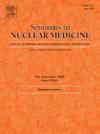优化CT成像参数:对核医学诊断准确性的影响。
IF 5.9
2区 医学
Q1 RADIOLOGY, NUCLEAR MEDICINE & MEDICAL IMAGING
引用次数: 0
摘要
x射线计算机断层扫描(CT)是分子成像中一种重要的辅助方式,它提供了单光子发射计算机断层扫描(SPECT)和正电子发射断层扫描(PET)数据的衰减校正(AC)、扫描中的地形信息以及一系列随访研究中的形态学变化。图像质量在提供可接受的诊断和医疗计划中起着关键作用。协议的可变性可能会对在部门内实现一致的图像质量提出相当大的挑战。不同制造商和不同一代扫描仪建立的CT扫描协议指标的差异可能导致这一问题,使图像质量的标准化成为一项复杂的任务。本文旨在介绍相关文献,介绍CT成像参数,包括采集因素、重建算法和相关图像质量指标,并讨论在核医学部门实施稳健的CT协议审查流程的可能方法。我们还评估了迭代重建(IR)和深度学习(DL)在提高图像质量和减少暴露剂量方面的潜力。本文指出需要定期审计图像质量,以保证CT协议适合预期目的。通过创建本地诊断参考水平和通过协议管理监测绩效,医生可以致力于始终坚持ALARA原则并减少患者和工作人员的剂量,提供高质量的成像服务。本文章由计算机程序翻译,如有差异,请以英文原文为准。
Optimizing CT Imaging Parameters: Implications for Diagnostic Accuracy in Nuclear Medicine
X-ray computed tomography (CT) is an important companion modality in molecular imaging, offering attenuation correction (AC) of single-photon emission computed tomography (SPECT) - and positron emission tomography (PET)-data, topographic information in scans as well as changes in morphology in serial follow-up studies. Image quality plays a critical role in delivering an acceptable diagnosis and in medical treatment planning. Variability in protocols can present a considerable challenge in achieving consistent image quality within departments. The differences in CT scanning protocol metrics established by various manufacturers and across different generations of scanners can contribute to this issue, making the standardization of image quality a complex task. This review aims to present relevant literature herein and provide an introduction of the CT imaging parameters, including acquisition factors, reconstruction algorithms, and relevant image quality metrics, and discuss possible ways to implement a robust CT protocol review process in a nuclear medicine department. We also evaluate the potential of iterative reconstruction (IR) and deep learning (DL) for enhancing image quality and minimizing exposure doses. This article points to the need for periodic audit of image quality to guarantee that CT protocols are suited for the intended purpose. Through the creation of local diagnostic reference levels and monitoring performance through protocol management, physicians may aim at delivering high quality imaging services consistently adhering to the principles of ALARA and reduction of dose for both patients and workers.
求助全文
通过发布文献求助,成功后即可免费获取论文全文。
去求助
来源期刊

Seminars in nuclear medicine
医学-核医学
CiteScore
9.80
自引率
6.10%
发文量
86
审稿时长
14 days
期刊介绍:
Seminars in Nuclear Medicine is the leading review journal in nuclear medicine. Each issue brings you expert reviews and commentary on a single topic as selected by the Editors. The journal contains extensive coverage of the field of nuclear medicine, including PET, SPECT, and other molecular imaging studies, and related imaging studies. Full-color illustrations are used throughout to highlight important findings. Seminars is included in PubMed/Medline, Thomson/ISI, and other major scientific indexes.
 求助内容:
求助内容: 应助结果提醒方式:
应助结果提醒方式:


